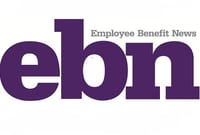 In a previous blog post, we asked, “Why dump mandatory distributions in a landfill when you can recycle?” As we wrote then, sponsors exercising their authority to automatically roll over separated participants’ small balances into safe harbor IRAs—without encouraging participants to take their retirement account savings with them at the point of job change, or facilitating “auto portability” to make plan-to-plan asset transfers a seamless process—are doing themselves and their participants a disservice in the long run.
In a previous blog post, we asked, “Why dump mandatory distributions in a landfill when you can recycle?” As we wrote then, sponsors exercising their authority to automatically roll over separated participants’ small balances into safe harbor IRAs—without encouraging participants to take their retirement account savings with them at the point of job change, or facilitating “auto portability” to make plan-to-plan asset transfers a seamless process—are doing themselves and their participants a disservice in the long run.
It’s worth asking the same question to sponsors unintentionally creating even bigger problems for themselves and their participants by continuing to automatically cash out small, stranded accounts with balances of less than $1,000.
According to Aon Hewitt’s 2013 Universe Benchmarks report, 81% of plan participants terminated in 2012, and who had balances of less than $1,000, received cash distributions after their separations. The vast majority of those participants were automatically cashed out by sponsors, and the trend is not only continuing, but worsening; two years earlier, Aon Hewitt reported that 75% of these small balance participants were handed their retirement savings in the form of an after-tax check.
Automatically cashing out separated balances with under $1,000 may be the easiest of three options for sponsors to keep their plans tidy, but as the saying goes, “the easy or popular choice isn’t always the right one.”
The other two choices—automatically rolling these small accounts into safe harbor IRAs, or enabling auto portability so the balance can be automatically rolled into a participant’s current-employer plan—are much safer and more beneficial.
Safe Harbor IRAs: Better Safe Than Sorry
Some sponsors may be apprehensive about rolling small accounts into safe harbor IRAs because they fear being held liable for managing the products. While sponsors do have a responsibility as fiduciaries to act in the best interests of participants, and not all safe harbor IRAs are truly “safe”, cashing out small balances carries a greater degree of fiduciary liability than automatically rolling them into safe harbor IRAs.
Unlike cash-outs, automatic rollovers at least allow separated participants’ assets to remain invested, pre-tax, in the retirement system, and they also enable participants to retain control over their assets if/when they track them down. On the other hand, if a sponsor cashes out the less-than-$1,000 balance of a lost/missing participant, the assets remain in the plan until the check is cashed, and the sponsor must continue to send required disclosures to the participant as long as the check is not cashed. By moving the balance to a safe harbor IRA, the sponsor is assured that the participant is out of the plan—and responsibility for finding lost participants is transferred to the safe harbor IRA provider.
The Right Choice: Embracing Auto Portability
Automatic rollovers are better than automatic cash-outs for cleaning up small accounts, but the ideal long-term solution is for sponsors to enable seamless, automatic plan-to-plan portability so that participants can easily take their retirement savings with them when they leave. This option not only increases plans’ average account balances, but also reduces cash-outs and encourages lifetime participation in the U.S. retirement system (which leads to the best retirement outcomes for participants). In addition, most plans use a target date fund as their qualified default investment option—this is a far better default investment vehicle for retirement-investing than the money market default investment options required for safe harbor IRAs.
Fortunately, it’s easy for sponsors to facilitate the two-way flow of assets into and out of their plans, and most participants would happily take advantage of it. As the Plan Sponsor Council of America reported in its industry survey released in January of this year, 97.6% of defined contribution plans are capable of accepting roll-ins from other plans. In addition, a Boston Research Technologies study of mobile workforce behaviors published in 2015 found that most Millennials, Generation-Xers and Baby Boomers would roll their 401(k) accounts into their current employer’s plan if the employer paid for it—and even more would roll in IRAs if the employer paid for that too.
With the White House on board with making portability easier for participants, more nationwide cooperation on the transfer of retirement savings appears on the horizon. At such a promising time for the retirement system, sponsors that continue to automatically cash out separated accounts with less than $1,000 are unintentionally contributing to (as opposed to decreasing) the problem of leakage—as well as opening themselves up to increased fiduciary liability.
- Home
- Individuals
- Auto Portability
- Plan Sponsors
- The Small Account Problem
- RCH Portability Services
- Plan Sponsor Support
- The Missing Participant Problem
- What is a Missing Participant?
- Why Plan Sponsors Should be Concerned
- What Causes Missing Participants?
- The Magnitude of the Problem
- What Regulations Apply to Missing Participants?
- Sources of Uncertainty for Plan Sponsors
- Best Practices for Finding Missing Participants
- What to Look For in a Search Service
- Learn More About Missing Participants
- RCH's Missing Participant Search Service
- Terminating 401(k) Plans
- Participant Testimonials
- Due Diligence Material
- Contact Us
- Accountholders
- Company
- News & Information
- Login
